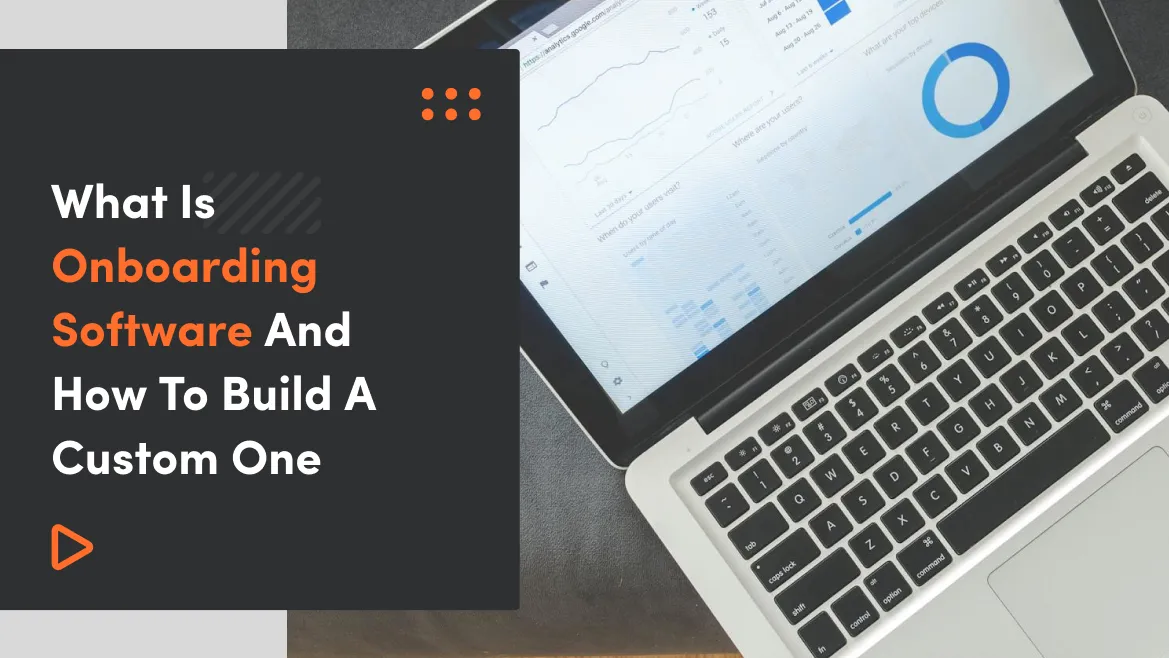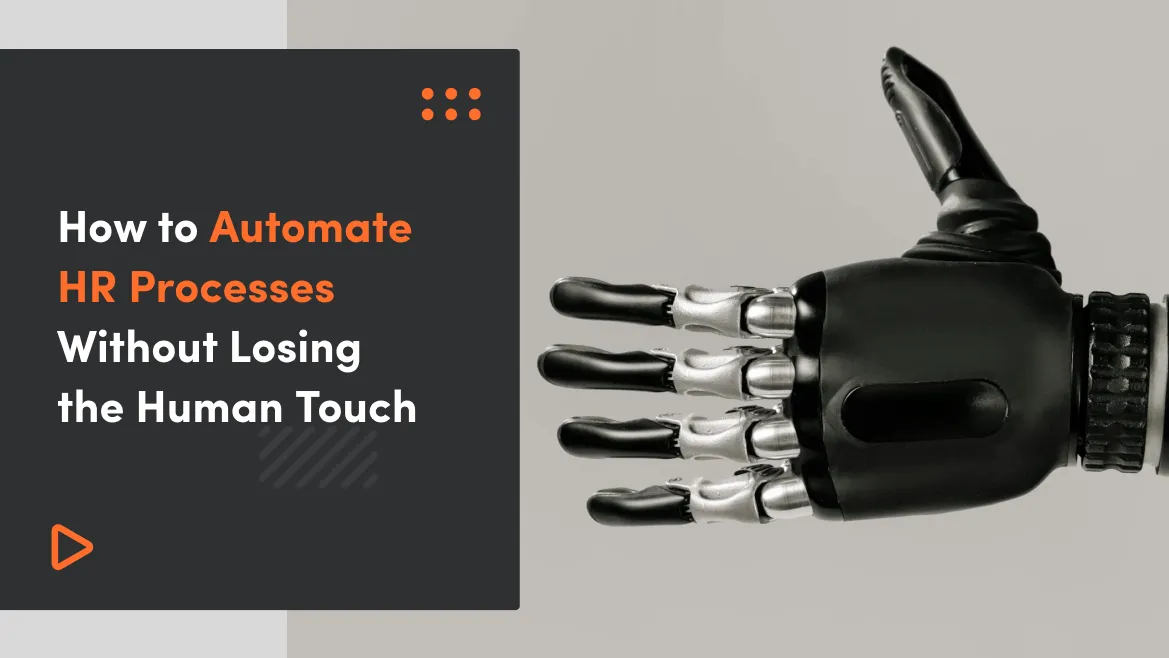A clear start matters. Many teams learn this the hard way when new hires feel lost, miss steps, or wait for simple access. Onboarding software solves this by putting tasks, documents, and training in one calm place. It helps people understand what to do next without long searches or guesswork. This article shows what onboarding software is, how it works, and how you can build a custom version that fits your team and tools.
Key Takeaways
-
Onboarding software gives new hires one clear place for tasks, documents, and training.
-
Simple workflows remove chaos and save HR teams many hours of manual work.
-
Good onboarding improves both employee onboarding and customer onboarding.
-
Integrations with ATS, HRIS, and payroll make the whole process faster and cleaner.
-
Custom onboarding software makes sense when your workflows are complex or unique.
What Is An Onboarding Software? Employee Onboarding Software & Customer Onboarding Explained
Onboarding software is a simple digital tool that guides a new person through their first steps in a company or product. It puts all tasks, documents, and training in one clear place, so the onboarding process feels calm and easy. Mobile accessibility enhances the convenience of onboarding software for remote and deskless employees, allowing them to complete tasks and access resources from their smartphones or tablets. Onboarding software should support mobile optimization to ensure new hires can seamlessly engage with the platform on the go.
This type of software comes in two main forms. One supports employee onboarding inside a company. The other supports customer onboarding inside a product. Both forms help a new person understand what to do next without searching through emails or chat messages. Onboarding software is essential for remote and distributed teams to provide virtual access to training, documents, and communication tools.
Employee onboarding software helps HR teams and managers. It shows each new hire a clear path from pre-boarding to the first weeks at work. It can collect basic data, show onboarding workflows, and keep all onboarding tools in one place. New hires feel safe when they see one simple screen that shows what to do today.
Customer onboarding software is different because it focuses on new users of a product. It shows short steps inside the app. It can highlight key features and guide people to their first real result. A simple path helps users understand the product faster and reduces early confusion.
Both types sit above other HR software and CRM tools. They do not replace them. They work with them. Onboarding systems pull the right data from these tools and turn it into clear onboarding flows for real people.
Many teams explore a short product discovery session before choosing the right onboarding software. It helps them see what steps matter most. This simple check often prevents expensive mistakes later.
A strong onboarding process supports more than day one. It starts before the first login and continues through the early training process. It can cover simple tasks, short videos, and small goals. This early structure supports the entire employee lifecycle and makes the first weeks feel safe.
Some teams want simple checklists. Some want an onboarding platform with deeper onboarding workflows. Some teams need user onboarding tools that support many specific user groups. The best onboarding software is the one that fits your size, your people, and your tools.
Good design plays a large role here. Many teams study real UX design examples when they build or choose a system. Clear design helps people learn faster. A simple screen removes stress on the first day.
I have seen teams try to onboard people with emails, PDFs, and long lists. It creates chaos. People forget steps. HR teams lose track. No one knows what is done or who is stuck. One clean onboarding platform removes this problem at once.
3 Key Onboarding Software Features – Core HR Processes & Custom Workflows
The key features of onboarding software are very simple. It should give clear checklists, manage tasks and documents, and support custom workflows for your HR processes. Many onboarding software platforms offer analytics to track new hire progress and gather feedback for improvement, helping HR teams refine their processes over time.
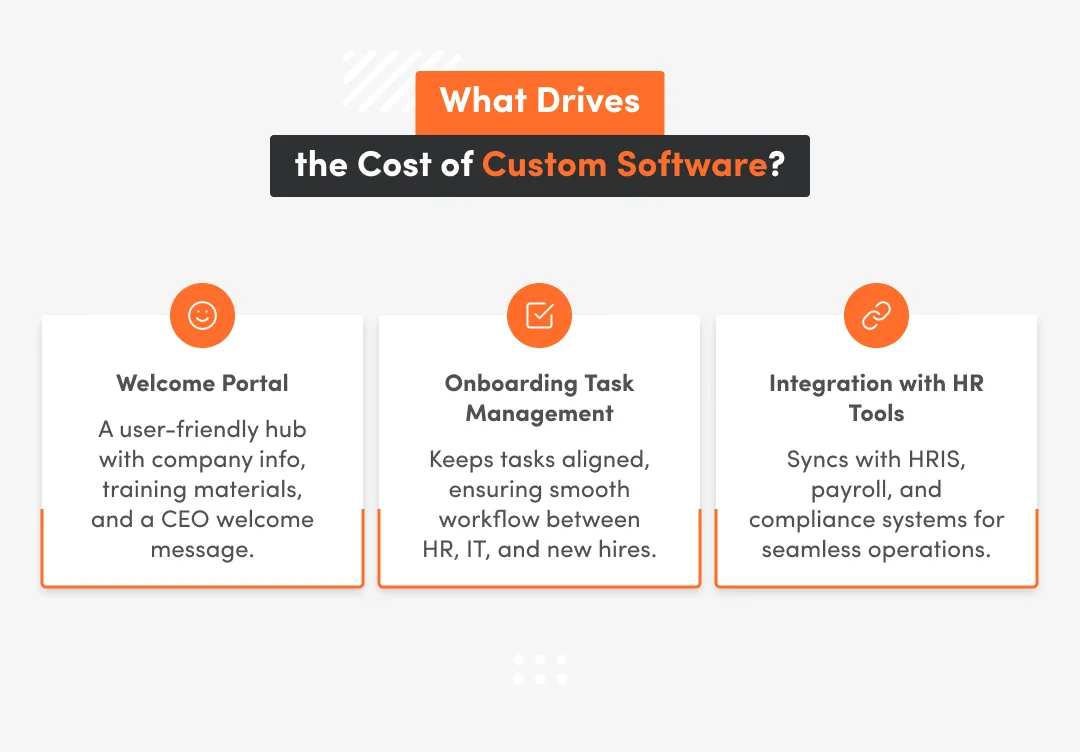
When these parts work together, HR teams get one onboarding platform that feels calm and clear. New hires see what to do. HR departments see who is stuck. Good onboarding tools turn a messy onboarding process into a set of small, easy steps.
From my own experience, teams do not need a long list of fancy functions. They need a few strong building blocks that work well together. A small set of key features is better than a big list that no one understands.
Below you see three core areas that shape modern onboarding software. They cover the welcome portal, tasks and checklists, and integrations. These areas support daily HR processes and allow custom workflows for many roles.
Strong onboarding software gives every new hire a clear list of steps, a safe place for documents, and simple workflows that match real HR processes.
Welcome Portal – Improving Employee Engagement & Customer Support
A welcome portal is the first screen a new hire sees in the onboarding platform. It is one simple page that shows tasks, documents, and training in one place.
This portal can act as an employee self service portal. The new hire logs in and sees their onboarding checklist, key dates, and links to onboarding resources. They can move through onboarding materials at their own pace. Self service helps people feel in control from day one.
Most welcome portals work best with very clear design. One main view. Simple labels. A clear sign of onboarding progress. Some teams ask a web design company to shape this view. Good design keeps the portal easy to scan for a stressed new hire.
The portal can also support customer support and HR teams. It can show a small area with contact options. This can be a chat icon, a link to a knowledge base, or a simple message form. New hires know where to ask for help, which calms a lot of early fear.
From what I have seen, engagement rises when people see this portal before day one. They feel welcome. They feel expected. They also understand that the company has a plan for them. A clear welcome portal is often the first strong signal of a serious onboarding process.
A welcome portal gives each new hire one self service page with tasks, training, and help, so they never need to guess what happens next.
Onboarding Tasks Management – Key Features for HR Teams
Onboarding tasks management is the heart of onboarding software. It turns a long list of actions into clear onboarding checklists for real people.
HR teams can create one onboarding checklist for each role or location. Each checklist holds onboarding tasks for HR, IT, managers, and the new hire. The system can assign tasks to each person. Assign tasks in software, not on paper, and you will see fewer missed steps.
Task automation is a key part here. When a new hire joins, the onboarding platform can create all related tasks at once. It can send simple reminders. It can move items from “open” to “done” when someone clicks a button. Workflow automation like this saves HR teams from manual follow up in email.
A good tool also gives clear views of onboarding progress. HR departments can track progress for each new hire in one list. They can see who has finished the training process and who still waits for software access. Track onboarding progress in one screen and you know where to step in.
Tools like Process Street or Workable HR use this model in many companies. In one client case, we moved their paper checklists into a digital task board. The HR team could see all hires in one place. They told us the biggest change was simple peace of mind. Rippling automates employee onboarding by sending offer letters, collecting tax forms, and setting up software access, showcasing how automation can simplify and enhance the onboarding experience.
When onboarding tasks are clear and tracked in one place, HR teams stop chasing people and start helping people.
Integration – Connecting HR Software, Applicant Tracking Systems (ATS) & Customer Onboarding Tools
Integrations connect the onboarding platform to the rest of your tools. They let data move from one system to another without extra typing.
A common start is a link to an applicant tracking system. When the hiring process ends and a candidate accepts, the ATS sends basic employee data to the onboarding software. This can create the onboarding flows for that person at once. This step removes manual copy and paste between systems.
Read also: How To Choose The Best Recruiting Software?
Next, many teams connect their HR software, payroll system, and tools for global payroll. When these tools talk to the onboarding platform, new hires get software access at the right time. People get the accounts they need without long waits and manual emails.
Integrations can also link to project management tools and user onboarding tools. This link helps coordinate internal work and the entire customer journey at the same time. Some teams extend their product with onboarding features using SaaS development services. This path works well when the product itself is the place where onboarding happens. Onboarding software integrates with other HR and IT systems, like Azure Active Directory, to automate user creation and streamline workflows, further enhancing efficiency.
From my point of view, you do not need every integration at once. Start with one or two key software integrations. For example, ATS and HRIS. Add others later. Good onboarding systems grow step by step with your real needs.
In one project, we saw a company connect their ATS, HR system, and basic reporting tools. HR teams could see all hires complete their flows and run simple reports. IT teams stopped creating accounts by hand. The result was fewer errors, faster starts, and less stress across all teams.
Integrations turn onboarding software from a stand alone tool into a simple hub that connects hiring, HR, payroll, and customer onboarding.
4 Key Benefits of the Onboarding Software – Best Onboarding Software Advantages
The right onboarding software brings very clear business benefits. It lifts employee engagement, speeds up new hire onboarding, lowers HR effort, and supports the entire employee lifecycle. Greenhouse Onboarding automates tasks tied to each hire's role and gathers real-time feedback, further demonstrating how the right tool can streamline processes and improve outcomes.
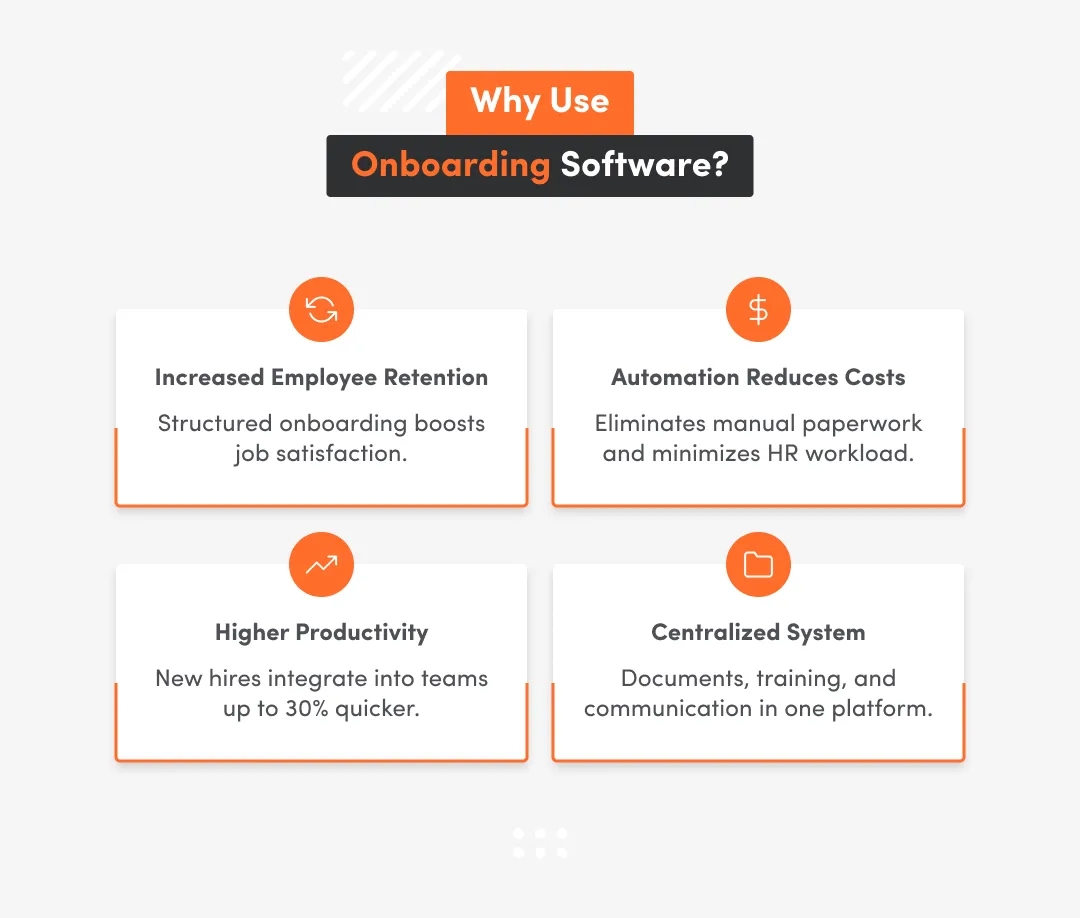
From my own experience, the pattern is simple. When you move from email and spreadsheets to a structured tool, things stop slipping through the cracks. An efficient onboarding process is often enough to change how new hires see the company.
The impact shows up in a few key places. People feel welcome. Managers see hires complete their steps. HR teams spend less time on manual follow up. Customers also feel the effect when user onboarding is smoother. A strong onboarding process supports both your internal teams and your clients.
Good onboarding software is not a one-off project. It is a product inside your company. When you build or extend it with a clear software development process, you can keep improving it over time. This long view is what turns simple tools into real business assets.
The best onboarding software raises engagement, speeds up time-to-productivity, cuts manual work, and supports compliance across the entire employee lifecycle.
Smooth Onboarding Process Motivates New Hires – Enhancing Employee Engagement
A smooth onboarding process makes new hires feel safe and welcome. It shows that the company is ready for them and has a clear plan.
In practice, this means that new hires know what will happen in their first days and weeks. They see a simple list of steps. They know who they will meet. They know which tools they will use. This clarity is one of the easiest ways to boost early employee engagement.
I remember working with a team that moved from a loose plan to a structured flow in Absorb LMS and Enboarder. New hires reported that they felt informed and less anxious. Managers also felt more prepared. People tend to stay longer when they feel supported from the start.
A strong onboarding process does more than cover day one. It supports new hire onboarding through the first months. It links to early performance talks and light feedback. This connection between onboarding and performance management shapes the entire employee lifecycle.
When new hires feel guided and welcome in their first weeks, their engagement and loyalty grow much faster. Effective onboarding can significantly reduce turnover rates by making new employees feel connected to the organization, fostering a sense of belonging and commitment.
Automation of the Onboarding Process Reduces Cost – Streamlining HR Processes
Automation removes many small, boring tasks from HR processes. It lets HR teams focus on people, not on chasing paperwork.
In a manual setup, HR staff send emails, remind managers, and track updates in separate files. With automation, onboarding software creates tasks, sends reminders, and updates status as people move through steps. Even simple automated workflows can save many hours each month.
I have seen GoCo and similar tools cut manual effort for HR teams in a very clear way. Steps that once required three messages now happen with one click. Many actions, like sending forms or nudges, run on their own. Less manual work often leads to lower cost per new hire.
Automation also reduces risk in business processes. Fewer steps are forgotten. Fewer tasks sit in someone’s inbox. The system does not get tired or distracted. This steady support helps HR teams keep quality high even when the volume of new hires grows.
When onboarding tasks run through simple automation, HR teams save time, reduce errors, and lower the real cost of each new hire.
Onboarding Automation Increases Productivity – For Both Employee and Customer
Onboarding automation speeds up how fast people reach real value. New employees and new customers both get to productivity faster when they know exactly what to do next.
For employees, automation can unlock software access and training at the right time. They get logins on day one. They see short lessons that match their role. They move through the training process in a clear order. Role specific training plus fast tool access lead to earlier impact at work.
For customers, automated user onboarding flows guide them through key actions in a product. Tools like iSpring or in-app guides such as UserGuiding show small tasks one by one. People learn by doing. Better user adoption and user engagement often follow this kind of guided experience.
In one project, a client used Enboarder for employees and a product tour for customers at the same time. New staff ramped up faster. New customers reached their first result earlier. When both sides move faster, the whole system feels more productive and more stable.
Onboarding automation gives people the right tools and lessons at the right time, so they reach real productivity much sooner.
No Paperwork – Centralized System for HR Teams & Customer Support
Paperwork slows everyone down. It is easy to lose and hard to track. A centralized system for documents makes onboarding simpler and safer. Onboarding software should facilitate compliance by automating document collection and ensuring legal requirements are met, reducing the risk of errors and missed steps. Additionally, it collects compliance documents and manages employee training, ensuring that all necessary steps are completed efficiently.
With document management in one tool, HR teams know where contracts, forms, and policy sign-offs live. There is one source of truth, not many folders and mail threads. Document storage in a single place reduces confusion and saves time.
Compliance tools inside onboarding software also help. They can make sure that key steps happen in the right order. They can record who signed what and when. They can remind people if something is still open. This support makes it easier to meet compliance requirements without extra stress.
Customer support also feels the benefit. When they can see the same record as HR, they can answer simple questions faster. They can confirm if a step is complete. They can guide new hires or users with more confidence. Shared access to clear records makes life easier for everyone who helps new people.
Centralizing onboarding documents and signatures in one system reduces errors, supports compliance, and makes daily work lighter for HR and support teams.
Try our developers.
Free for 2 weeks.
No risk. Just results. Get a feel for our process, speed, and quality — work with our developers for a trial sprint and see why global companies choose Selleo.
Who should use Onboarding Software? HR Teams, Customer Success & Growing Organizations

Any organization that hires on a regular basis or runs complex customer onboarding will gain a lot from onboarding software. It is most useful when a team wants clear steps instead of ad-hoc onboarding procedures.
From my experience, scale-up tech firms are often the first in line. Their number of new hires grows each quarter. HR teams cannot keep up with email and spreadsheets. They need onboarding systems that support an entire workforce with clear hr processes. When growth speeds up, a structured tool becomes a basic need, not a nice extra.
Distributed and remote companies also feel this pain. People work in different time zones and have different habits. A shared onboarding platform keeps everyone on the same page. It supports specific user groups like contractors, interns, or part-time staff. One system makes it easier to guide the entire employee lifecycle, even when people rarely meet in person. Deel supports onboarding for employees and contractors in over 100 countries with localized contracts and compliance tools, making it a strong choice for global teams.
Regulated sectors like FinTech or Healthcare have another reason. They must follow strict rules and prove that each step happened in the right way. Onboarding software helps them document key actions. It ties onboarding procedures to compliance and early performance management. This clarity reduces risk and protects the business.
Inside one company, different teams benefit in different ways. HR departments get a clear view of every new hire and all open tasks. Customer success teams see where customers are in the customer onboarding path. IT and security teams use the system to control software access. The tool connects these groups and enables hr teams to work with others as one unit.
Fast growing organizations often move from basic tools to integrated platforms. They link recruitment, HR, and onboarding in one flow. Some of them combine off-the-shelf tools with custom HRM Software development. This mix keeps daily work smooth and still fits unique business processes.
Large-scale hiring is a good stress test. In the education sector, the Case study Selleo Humly recruitment platform shows how structured workflows support both recruitment and onboarding. Many candidates pass through the system. The team can still keep high quality. Clear flows make volume feel manageable instead of chaotic.
How to Onboard Employees while Remote? Remote Employee Onboarding Software Guide
Remote employee onboarding works best when a clear onboarding process is supported by software that gives new hires self-service access to tasks, training, and support from day one. This mix of structure and tools keeps people close even when they are far away.
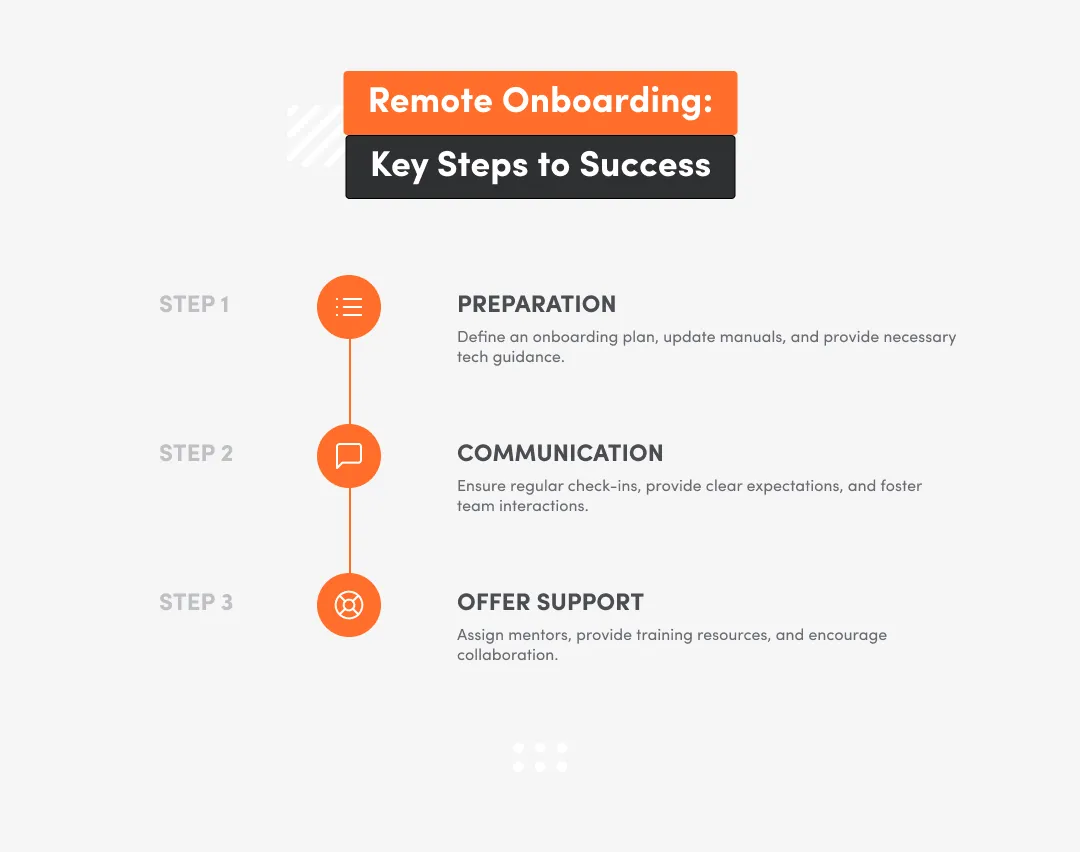
Remote and hybrid work remove the office as a safety net. New hires cannot lean on quick questions at a desk or small talks in the hallway. This is why remote employee onboarding needs more planning and more clear steps than in-office onboarding.
Employee onboarding software becomes the main space for this plan. It can act as an employee self service portal. New hires see their onboarding checklist, onboarding tasks, and key onboarding resources in one place. Self service helps people move through new hire onboarding at their own pace.
The onboarding process for remote teams often starts before day one. You can plan a simple “week onboarding” path and then the first 30, 60, and 90 days. Onboarding workflows show which training process happens in which week. New hires feel better when they see a simple map, not a blank screen.
Some teams even layer Artificial Intelligence solutions on top of their onboarding software. These tools can suggest onboarding materials and training schedules that match the role or location. This keeps content relevant and supports user engagement for remote hires.
Remote onboarding works when a clear process meets simple software that shows each new hire what to do, learn, and ask, without guessing.
Step 1: Preparation – HR Processes, Documentation & Access Setup
Preparation means defining your remote onboarding procedures, preparing documentation, and setting up software access before the new hire’s first day. Most problems with remote onboarding start when this step is rushed or skipped.
HR teams can begin with a clear onboarding checklist for remote new hires. The list can include accounts, intro calls, and basic training process steps. It can live inside employee onboarding software, ready to reuse. A good checklist turns a vague plan into a repeatable onboarding process.
Next, collect and organize onboarding resources and onboarding materials. These can be short guides, short videos, and policy summaries. Tools such as WorkBright or Enboarder help share these items in small, clear pieces. Remote new hires should see only what they need now, not every document at once.
IT and security teams prepare software access. They create accounts for key tools like email, chat, and project boards. They sync this work with HR processes and the planned week onboarding. New hires should log in on day one with everything ready, not spend hours waiting for access.
You can also decide which metrics to track. For example, you can use tools like Google Analytics or built-in reporting to watch how many people open key links. You can check how fast they finish early onboarding tasks. Simple numbers help you see if your onboarding procedures really work for remote teams.
Remote onboarding starts well when checklists, documents, and access are ready before the new hire ever logs in.
Checklist for Step 1:
- Define one remote onboarding checklist per role.
- Upload core onboarding materials and policy documents.
- Prepare accounts for all tools the new hire needs.
- Align HR teams and IT on timing for software access.
- Decide which simple onboarding metrics you want to track.
Step 2: Communicate – Employee Engagement, Customer Support & Clear Channels
Clear, planned communication is what keeps remote employees engaged and stops them from feeling lost during onboarding. Silence in the first week is one of the fastest ways to lose a new hire.
A simple plan can help. You can set a few key calls in advance. For example, a welcome call with HR, a team call, and a one-to-one with the manager. Tools like Enboarder or Workable HR can send invites and reminders. New hires relax when they see who they will meet and when.
Next, you define channels for questions. This can be a chat space in Slack or Teams, a shared email address, or a small form inside the onboarding system. HR teams, IT, and even customer support can watch these spaces. The goal is simple. New hires must know where to ask and expect a quick answer.
You can also use software to keep employee engagement high. Short messages, small check-ins, and simple polls help you see how people feel. You can link these touchpoints to the training schedules in the tool. Regular contact shows that someone is watching their progress and cares about their start.
From my own experience, remote new hires rarely complain about too much structure. They prefer clear plans and clear channels. They worry most when they do not know what happens next. A light but steady flow of communication keeps user engagement and trust high in the first weeks.
In remote onboarding, planned calls and clear channels matter more than fancy content, because silence feels like neglect.
Simple communication plan for remote onboarding:
- Welcome email with dates, links, and the onboarding checklist.
- Day one call with HR to walk through the employee self service portal.
- Team call in the first week to build early bonds.
- Weekly check-ins in the first month with the manager.
- Clear channel for questions to HR, IT, and support.
Step 3: Offer Support – HR Teams, Training & Custom Workflows
Remote onboarding software should make it easy for HR teams to support new hires through tailored training flows and quick access to help. Support is not only about solving problems, but also about guiding people through the right learning path.
Custom onboarding workflows are a strong tool here. You can design different paths for specific user groups. For example, engineers, sales staff, or contractors. Each path can have its own set of onboarding tasks and role specific training. One size rarely fits all in remote employee onboarding.
Learning tools like iSpring Learn, Absorb LMS, or SkyPrep can host the training process. They can break content into small, remote-friendly lessons. Onboarding workflows inside your main system can point new hires to the right lesson at the right time. Short, focused training keeps people active and less tired. Absorb LMS supports role-based training and tracking with features for engagement and gamification, enhancing the learning experience for new hires.
HR teams also need easy ways to collect feedback. You can add small forms after key steps. You can ask new hires how clear the onboarding materials were or if the pace felt right. This feedback helps you improve your onboarding workflows over time.
In one remote project, a client built paths for developers, support agents, and part-time staff. Each group had its own training plan and support channel. Completion rates went up. People asked fewer “where do I find this” questions. Tailored flows showed new hires that the company understood their work.
Remote onboarding support works best when training flows fit the role and help is always one click away.
Support elements for remote onboarding:
- Custom onboarding workflows per role and group.
- Role specific training mapped to clear steps.
- Simple feedback forms after key milestones.
- One space with links to all help channels.
- Regular reviews of data and comments from new hires.
7 Things to Consider to Build a Custom Onboarding Software – HR Software & Customer Onboarding Perspectives
Before you build custom onboarding software, you should be clear on the value, the workflows, and the integrations you need. Your onboarding platform has to fit both HR software and customer onboarding, not sit beside them. Choosing the right onboarding software requires a clear understanding of your business needs and the specific challenges faced by HR teams, ensuring the solution aligns with organizational goals.
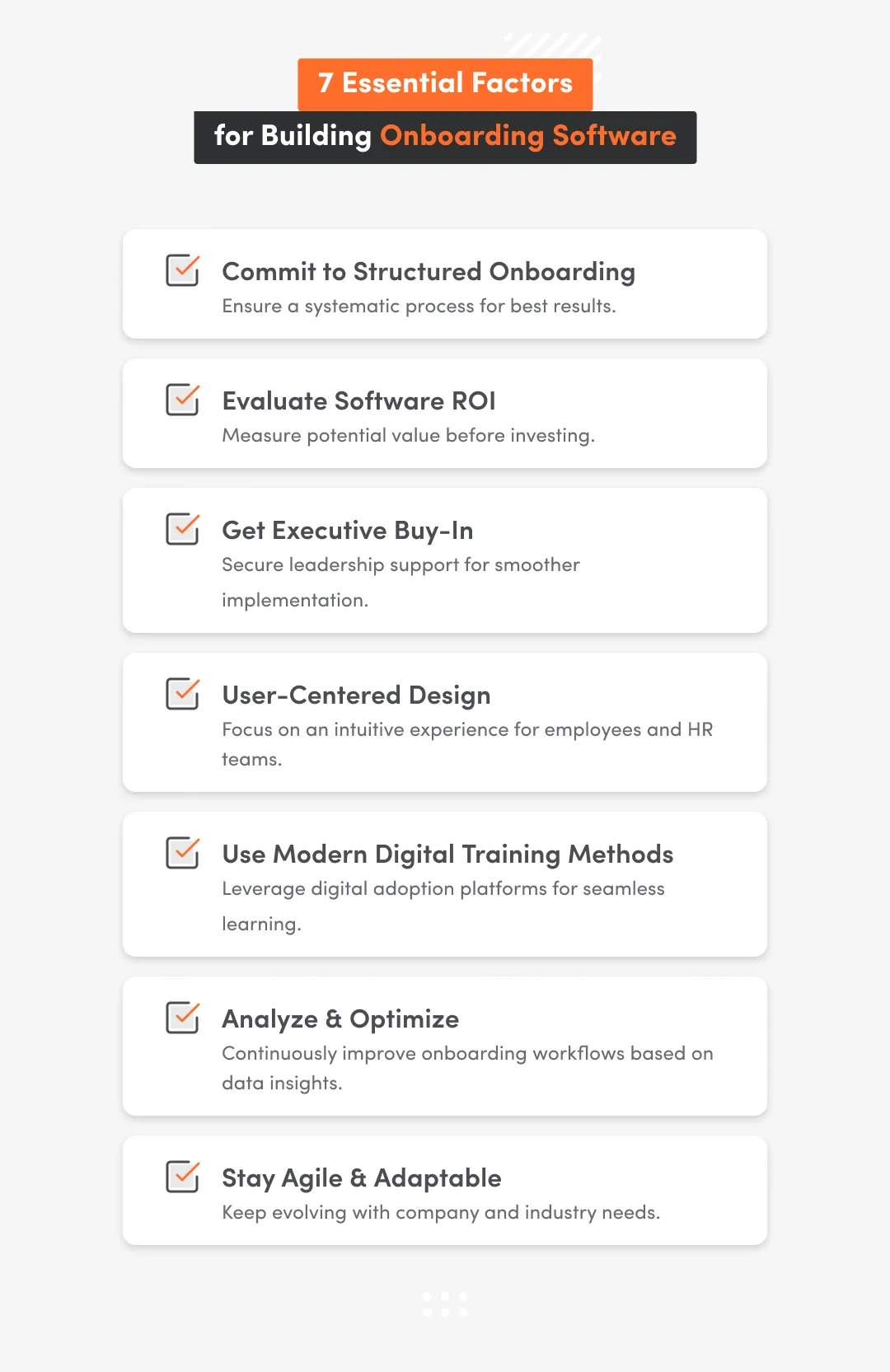
From my own experience, the best projects start with a simple view. You list the key hr processes and business processes you want to improve. You check where onboarding tools do not cover your real needs today. Custom onboarding workflows make sense only when standard tools block you.
Building a tailored onboarding platform is essentially a custom software development project that must align with your HR and IT strategy. You treat it like any other core system. You think about onboarding workflows, onboarding flows, and long term change. This mindset keeps the project grounded and realistic.
You also need to look at the full stack. That means each applicant tracking system, each HRIS, each payroll system, and your project management tools. You check which software integrations are easy and which are hard. Custom workflows are only useful if data can move across tools without manual copy and paste.
Before you build custom onboarding software, clarify its value, map your workflows, and plan how it will connect to every system that already runs your people and customer journeys.
Prioritize and Commit to Structured Software Onboarding – Employee Onboarding & HR Teams Alignment
You should start by deciding which parts of employee onboarding the software must support first. You do not need to digitize every step on day one.
HR teams can list the most painful hr processes. This often includes hire onboarding, access setup, and early performance management steps. You can group these into a simple MVP scope. A clear MVP scope protects you from trying to solve the entire employee lifecycle at once.
Next, you align the tool with your existing onboarding procedures. You do not throw away everything that works. You move only the steps that benefit from structure and automation. A strong onboarding process grows from what you already have, not from a blank slide.
In my work with HR leadership, I often see a pattern. Teams that focus on three or four core flows deliver their onboarding platform faster. They expand later, when people trust the system. Focus beats size in the first release of any onboarding platform.
Custom onboarding works best when you start small, support the key HR processes, and then grow from real usage.
Priority checklist:
- List 3–5 core employee onboarding flows you want to improve.
- Mark which hr teams own each flow.
- Decide what stays manual and what moves into software now.
- Lock this as your MVP and resist adding more until it runs.
Determine the Potential Value of Onboarding Software – For HR Processes & Customer Onboarding
You should estimate the value before you write any code. A rough business view helps you decide if custom onboarding is worth the effort.
You can look at business processes that touch both employees and customers. For example, how long it takes new hires to reach full productivity. Or how many steps in customer onboarding still happen by email. These numbers show where better onboarding can lift customer retention and quality.
Reporting tools are your friend here. You can combine simple dashboards with data from your ATS and HRIS. Some teams plug in tools like Google Analytics to watch how people move through current onboarding pages. Even a basic view of drop-offs helps you set realistic goals.
I have seen finance and HR analytics teams work together on this. They estimate time saved per hire. They guess the impact of fewer errors around compliance tools or missing documents. They also look at the cost of licenses for current onboarding tools that do not fit. This simple model shows if a custom path makes sense or not.
A simple value estimate is often enough to see if custom onboarding software will pay back its cost.
Value questions to ask:
- How much time does a new hire onboarding take today.
- How many tasks still sit in mail or sheets.
- Where do customers drop in your current customer onboarding flow.
- What is the cost of current tools that you hardly use.
Off-the-shelf vs Custom Onboarding – When Does Custom Make Sense?
This simple view helps you see when a custom onboarding platform is a lever and when a standard product is enough.
Executive Buy-In and Sponsorships – HR Teams, IT & Customer Success Leaders
Custom onboarding software needs leaders who care about it. Without shared sponsorship, the platform will stay a side project.
HR teams bring the view of hr processes and the entire workforce. IT teams bring technical limits and risks. Customer success leaders bring the view of customer onboarding and account health. You need all three to design something that fits daily work.
In practice, this means a small group of sponsors who meet often. They agree on priorities. They own decisions on scope, budget, and timing. They also help unblock topics with legal and security. Shared ownership reduces the risk of building a tool that no one feels responsible for.
I remember a project where HR owned the vision, but IT owned the budget alone. The result was slow and painful. When we brought in customer-facing leaders and shared the goals, progress picked up. Aligned leaders turn onboarding tools into real company systems, not side apps.
Custom onboarding succeeds when HR, IT, and customer leaders see it as a shared product, not as someone else’s tool.
Software Should be User-Centric – Best Onboarding Software UX Principles
The best onboarding software is pleasant to use. Powerful flows are not enough if people hate the screens.
You want an intuitive interface that feels simple even when logic behind it is complex. New hires should see clean steps and clear text. Managers should see status without digging. User engagement and user adoption depend a lot on how light the tool feels.

Best onboarding software often borrows patterns from in-app guides such as UserGuiding or video tools like Guidde. It shows the next action, not every possible action. It uses short messages and calm layouts. Small UX choices decide if people log in with relief or with dread.
In my work, I have seen teams fall in love with complex rule engines. They forget the front end. Usage stays low. After a UX refresh with simple labels and better navigation, numbers climb. Even strong onboarding workflows fail if the surface feels heavy.
A user-centric onboarding tool is the one that new hires understand in the first minute without any training.
User-centric design markers:
- Clear labels and short steps.
- One main action per screen.
- Simple overview for managers.
- Easy path back if someone gets lost.
Use Modern Digital Methods of Training – Supporting Employee Engagement & Customer Onboarding
Training inside onboarding should feel light and focused. Long slide decks do not work well for busy people.
Modern onboarding flows use short digital lessons. This can be microlearning modules, quick videos, or simple quizzes. You can line these up inside the training process with clear training schedules. Short lessons help employee engagement stay high through the first weeks.
Role specific training is also key. You can create different paths for specific user groups. Engineers see tools and examples that fit tech work. Sales staff see product talk tracks and demos. Partners see rules that fit their work model. People care more when content looks made for them.
Digital training also supports customer onboarding. You can reuse parts of these lessons for user onboarding, with a focus on value inside the product. This makes the change easier for both sides. Shared content saves time and keeps messages consistent.
Short, role-based digital lessons keep both employees and customers engaged without flooding them with content. UserGuiding lets organizations create interactive onboarding flows and contextual help within their applications, making it easier for users to navigate and understand the system.
Analyze and Optimize – Key Features, HR Processes & Custom Workflows
You should not treat version one of your onboarding platform as final. Real value comes from steady tuning.
Progress tracking is your basic tool here. You watch how people move through each step. You track onboarding progress and track progress per role and per location. You look at where people stop or slow down. Simple data often shows which parts of the flow feel heavy.
You can add reporting tools on top of the platform. Some teams use built-in dashboards. Others connect tools like Google Analytics or a BI tool. The goal is the same. You want to see how onboarding workflows behave over time. Numbers make it easier to pick the next small change.
Feedback from new hires and managers also matters. They can tell you which custom onboarding workflows feel smooth and which feel confusing. HR departments can collect these notes in regular reviews. Soft signals help explain what the hard data cannot show alone.
Good onboarding platforms improve each quarter, guided by simple progress data and honest feedback.
Simple analysis loop:
- Track who completes each step and when.
- Identify slow or confusing parts.
- Ask people why those parts felt hard.
- Change one thing at a time and watch the effect.
Don't be Afraid of Being Agile and Adaptable – Scaling Employee Onboarding Software & HR Tools
Your onboarding platform should grow with your company. Static tools break when the workforce changes.
It helps to think in small cycles. You plan, build, and ship often. You treat the system like any evolving hr software. Agile habits work well here. They let you respond to new roles, new markets, and new rules. An adaptive tool is safer than a huge one that never moves.
This mindset is vital when you move to a larger enterprise plan or add new regions. You can add new onboarding flows without a full rebuild. You can link new systems, like global payroll or inventory management, as needs grow. A flexible base protects your investment over years, not months.
I have seen teams that fear change freeze their onboarding tools. Over time, gaps appear. People go back to side sheets and shadow processes. Teams that accept change keep the platform simple but alive. They review flows each quarter and adjust. Living systems fit a living workforce.
The safest onboarding platform is not the one that never changes, but the one that is easy to change with your workforce.
Why Modern Onboarding Software Supports HR Teams, Customer Onboarding & Long-Term Engagement
Modern onboarding software is important because it supports hr teams every day and keeps people engaged for years. It links hiring, customer onboarding, and performance management into one clear system.
A strong onboarding process does more than welcome a new hire. It shapes how this person feels about the company for a long time. It sets norms, shows values, and explains how work gets done. Good onboarding systems turn the first weeks of work into a clear and calm start, not a test of patience.
For hr teams and hr departments this means less chaos. They can replace manual business processes with simple, repeatable flows. They see who started, who finished key steps, and where someone is stuck. When hr teams have one view of the entire workforce, they can support people instead of chasing missing tasks.
Customer onboarding also gains a lot from this. When employees know the product, the tools, and the rules, they help customers faster. Service feels more consistent. Issues get solved in a steady way. Clear internal onboarding quietly improves customer onboarding and supports customer retention. Sloneek provides onboarding tools integrated with broader HR functions like attendance and performance management, ensuring a seamless experience for both employees and customers.
Modern tools do not stop after week one. They support the entire employee lifecycle. They can link early goals with later performance management. They can show when someone is ready for new skills or a new role. Onboarding becomes the first step in a long path, not a separate event.
Over time, onboarding connects with pay reviews, growth talks, and learning plans. Many companies tie it to broader talent management software development efforts. They see it as part of one people system. The same data that starts in onboarding can guide fair decisions on growth and rewards.
From my own experience, this long view matters. Teams that treat onboarding as a one-time project see fast wins and then hit a ceiling. Teams that treat onboarding as a steady system see deeper change. They tune flows, adjust content, and involve managers more. The result is higher employee engagement and more stable teams.
Modern onboarding software also creates a quiet advantage on the job market. New hires talk about their first days with friends. Managers feel the difference when people start ready and calm. HR leaders see fewer low-value tasks on their plates. A strong onboarding process becomes one of the most visible signs of a healthy company, even if you never name it in a job ad.
Long story short. Off-the-shelf tools work well when you need structure fast and your process is simple. Custom platforms help when your onboarding has to match complex business processes and unique customer onboarding flows. The best choice is the one that supports your hr teams today and can grow with your entire workforce tomorrow. GoCo automates onboarding checklists, provides e-signature capabilities, and offers payroll integration, making it a versatile option for growing teams.
If you often lose track of steps, owners, or dates, your process has outgrown spreadsheets. If remote hires feel lost or repeat the same questions, you also see a clear signal. When HR spends more time chasing tasks than helping people, a dedicated tool starts to make sense.
You need checklists, tasks, and document management in one place. You also need clear progress tracking for each new hire. Simple workflow automation for reminders and handoffs is the next key layer.
Yes, the same logic of clear steps and small tasks can serve both groups. Employees see role and policy steps, while customers see product and value steps. You just design separate flows and content for each path.
Off-the-shelf tools are fine when your onboarding process is quite standard and you need value fast. Custom software makes sense when your workflows are complex or unique. It also fits when you need deep integrations or strict compliance control.
Data usually moves from the applicant tracking system into the onboarding system after hire. From there it flows into the HRIS and payroll to create a single record. Good integrations reduce manual typing and lower the risk of errors.
For remote teams it becomes a main workspace, not an extra. New hires see tasks, tools, and people in one place, even without an office. Clear flows and self service access help them feel part of the team much faster.
You can track time-to-productivity for new hires and compare it over cohorts. You can also watch completion rates for key steps and documents. Retention in the first 6–12 months is another strong signal.
